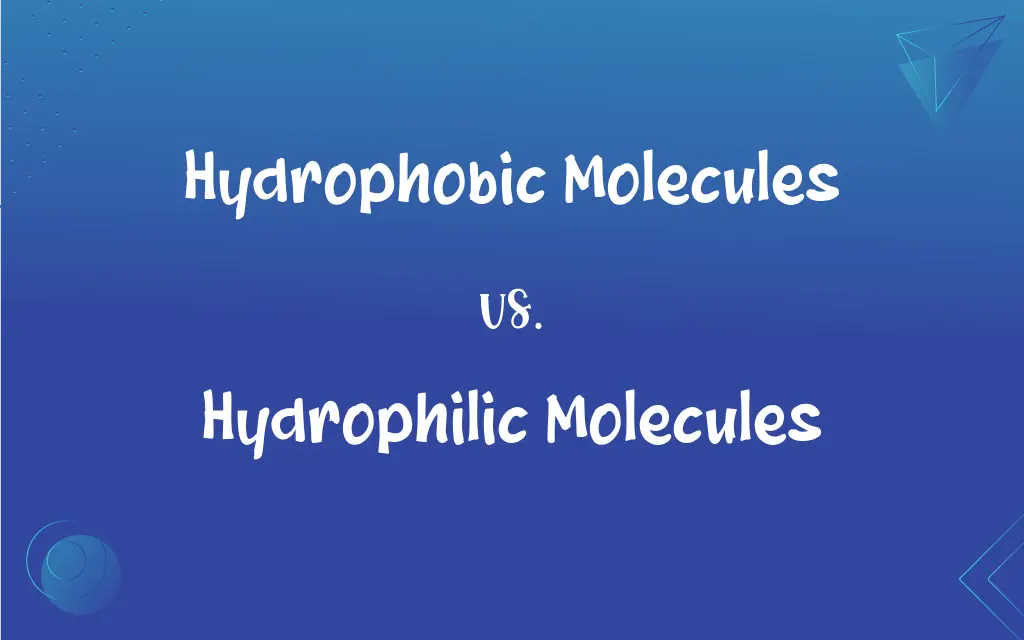Hydrophobic Molecules vs. Hydrophilic Molecules: What's the Difference?
Edited by Janet White || By Harlon Moss || Updated on October 20, 2023
Hydrophobic molecules repel water; hydrophilic molecules attract or dissolve in water.

Key Differences
Hydrophobic molecules are characterized by their aversion to water. These molecules do not mix well with water and often repel it. This can be attributed to the non-polar nature of hydrophobic molecules. Hydrophilic molecules, conversely, are molecules that have an affinity for water. They can mix, dissolve, or interact favorably with water due to their polar or ionic nature.
In the realm of biology, hydrophobic molecules play key roles in structures like cell membranes. The inner section of cell membranes is hydrophobic, keeping the interior of the cell protected from the external aqueous environment. Hydrophilic molecules, on the other hand, often reside on the outer or inner surfaces of cells, allowing interaction with the watery surroundings or cytoplasm inside the cell.
Hydrophobic molecules are usually non-polar, meaning they lack charged regions. Their electrons are distributed more evenly. This contrasts with hydrophilic molecules which are typically polar or ionic, having regions of positive or negative charges that can form bonds or interactions with water molecules.
The behaviors of hydrophobic and hydrophilic molecules can be observed easily. Oil, a hydrophobic substance, will separate and form a layer above water. Salts or sugars, which are hydrophilic, will dissolve in water. It's this distinction that governs a multitude of processes, both in nature and in various scientific applications.
Many practical applications, from industrial processes to drug delivery, hinge on understanding the behavior of hydrophobic and hydrophilic molecules. The design of certain materials or systems, for instance, might require control over these properties to achieve desired outcomes in fields ranging from nanotechnology to medicine.
ADVERTISEMENT
Comparison Chart
Affinity to Water
Repels or does not mix with water
Attracts or mixes with water
Charge
Typically non-polar
Typically polar or ionic
Examples
Oils, fats
Salts, sugars
Role in Biology
Found in cell membranes' interior
Often found on cell surfaces or in cytoplasm
Interactions with Water
Does not form hydrogen bonds with water
Forms hydrogen bonds or interactions with water
ADVERTISEMENT
Hydrophobic Molecules and Hydrophilic Molecules Definitions
Hydrophobic Molecules
Molecules that don't dissolve in water.
The hydrophobic molecules of the oil formed beads on the water's surface.
Hydrophilic Molecules
Water-loving substances.
The hydrophilic molecules on the cell surface interact with the surrounding fluid.
Hydrophobic Molecules
Water-averse substances.
Wax, due to its hydrophobic molecules, is used to repel water.
Hydrophilic Molecules
Molecules that attract water.
The hydrophilic molecules in sugar cause it to dissolve quickly in tea.
Hydrophobic Molecules
Compounds that lack affinity for water.
The hydrophobic molecules in the cell membrane protect the cell's interior.
Hydrophilic Molecules
Molecules that form bonds with water.
Hydrophilic molecules in some proteins allow them to stay suspended in blood.
Hydrophobic Molecules
Molecules that repel water.
Butter, being made of fats, consists of hydrophobic molecules.
Hydrophilic Molecules
Compounds that have an affinity for water.
The hydrophilic molecules in salt make it easily soluble in water.
Hydrophobic Molecules
Non-polar entities avoiding water.
The hydrophobic molecules in the salad dressing caused it to separate.
Hydrophilic Molecules
Polar or ionic entities that mix with water.
Soap contains hydrophilic molecules that allow it to lather in water.
FAQs
Are salts hydrophilic or hydrophobic?
Salts are hydrophilic since they dissolve in water.
Why does oil float on water?
Oil consists of hydrophobic molecules that do not mix with water.
Are sugars hydrophobic?
No, sugars are hydrophilic as they dissolve in water.
Do hydrophobic molecules have charges?
Typically, hydrophobic molecules are non-polar and lack charged regions.
Are proteins hydrophilic or hydrophobic?
Proteins can have both hydrophilic and hydrophobic regions, determining their function and location in cells.
What's an example of a hydrophobic interaction?
The clustering of oil droplets in water is a result of hydrophobic interactions.
Do hydrophobic molecules mix with water?
No, hydrophobic molecules repel or do not mix well with water.
How do hydrophilic molecules interact with water?
Hydrophilic molecules form hydrogen bonds or other interactions with water.
Why are some drugs designed to be hydrophilic?
Hydrophilic drugs can dissolve in the bloodstream and reach target areas in the body more easily.
Can hydrophilic molecules be non-polar?
Rarely, as most hydrophilic molecules have polar or ionic characteristics.
What role do hydrophobic molecules play in cell membranes?
Hydrophobic molecules form the inner section of cell membranes, protecting the cell's interior.
Can a molecule have both hydrophobic and hydrophilic regions?
Yes, such molecules are called amphiphilic or amphipathic.
Is wax hydrophilic or hydrophobic?
Wax is hydrophobic, which is why it repels water.
Why is understanding the difference between these molecules important in biology?
The behavior of these molecules determines many biological processes, such as the formation of cell membranes and the solubility of substances in blood.
How does the hydrophobic effect drive protein folding?
The hydrophobic effect causes non-polar amino acid residues to cluster together, away from water, shaping the protein's structure.
Why do hydrophilic molecules dissolve in water?
Hydrophilic molecules have polar or ionic regions that form interactions with water.
Are all polar molecules hydrophilic?
Most polar molecules are hydrophilic because they can interact with water.
Can hydrophilic molecules pass through cell membranes easily?
Typically, hydrophilic molecules require specific transport mechanisms to pass through the hydrophobic core of cell membranes.
How do soaps work given they have hydrophobic and hydrophilic parts?
Soaps have amphiphilic structures; the hydrophilic end attracts water, while the hydrophobic end attracts oils, allowing them to clean surfaces.
Is DNA hydrophilic or hydrophobic?
The phosphate backbone of DNA is hydrophilic, but the base pairs in its center are more hydrophobic.
About Author
Written by
Harlon MossHarlon is a seasoned quality moderator and accomplished content writer for Difference Wiki. An alumnus of the prestigious University of California, he earned his degree in Computer Science. Leveraging his academic background, Harlon brings a meticulous and informed perspective to his work, ensuring content accuracy and excellence.
Edited by
Janet WhiteJanet White has been an esteemed writer and blogger for Difference Wiki. Holding a Master's degree in Science and Medical Journalism from the prestigious Boston University, she has consistently demonstrated her expertise and passion for her field. When she's not immersed in her work, Janet relishes her time exercising, delving into a good book, and cherishing moments with friends and family.































































